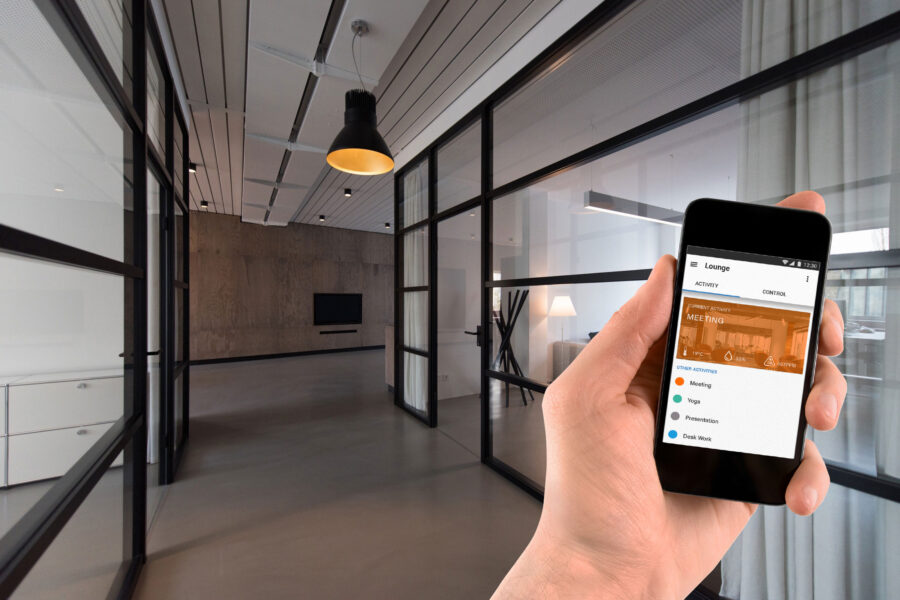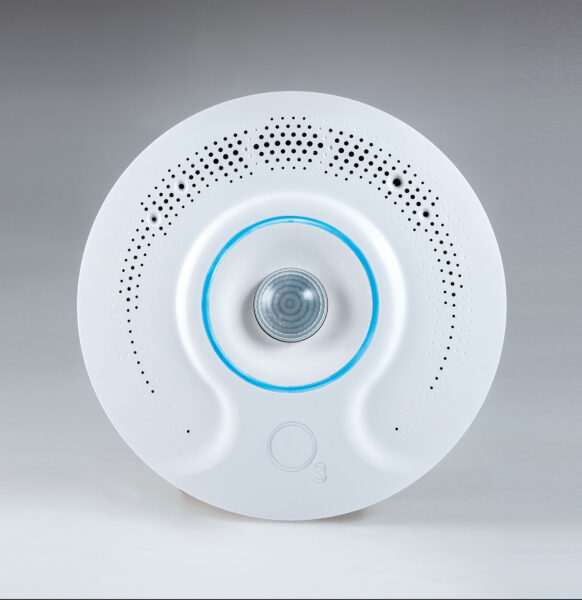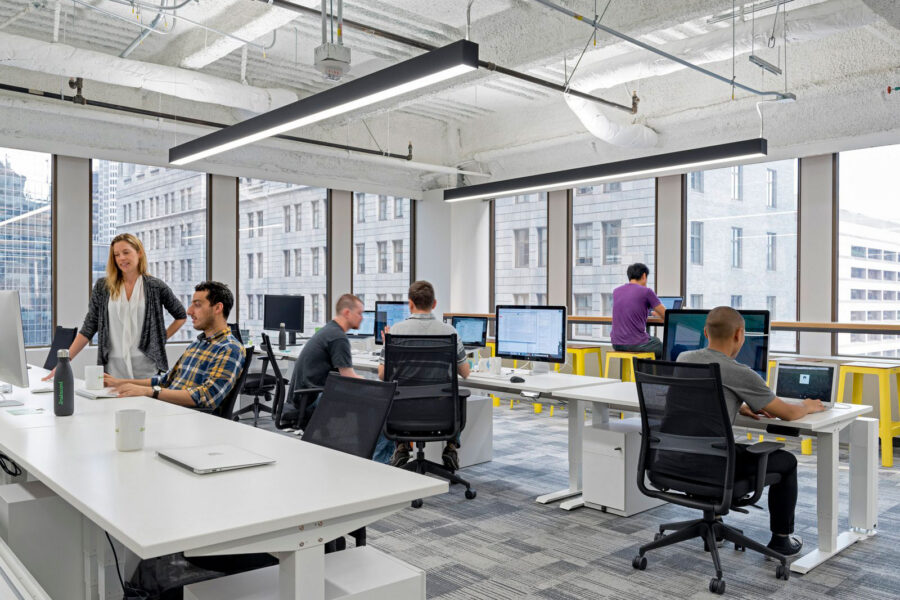- Ever increasing technological integration makes control of your building just a thumb’s swipe away.
- The ability to visually represent a building’s data so clients can understand and adjust what’s happening in their spaces is now reality.
- Delta Controls’ O3 Sensor Hub uses a combination of motion sensing, infrared temperature detection, and audio sensors to understand indoor environmental conditions. Their new Red5 product line allows customers to control HVAC, access, and lighting using one control module.
As technological integration, Internet of Things (Iot), and building automation in space design are increasingly normalized, designers and builders aren’t asking what they can do; they’re asking how to do it all better. Accessible interfaces, low profile hardware, integrated software, multi sensor controls—for even the most aesthetic of designers, new tech is a dream come true.
“There are direct correlations between how well you compete and how well you lead a team when it comes to performance,” says Darren Burns, director of innovation at Stantec. “And a lot of that comes down to how well and collaboratively you work together.”
The same is true for technological integration of our built systems—from lighting control to HVAC systems to building security and scheduling systems. Burns says he’s always looking for innovation that helps clients solve challenges they’re eager to solve. Increasingly both building designers and building occupants are finding those solutions through tech integration. “Stantec is looking at the ways in which this next evolution of data and digital innovation is transforming our environment to support transformational change,” he says.
Higher Integration

Photo courtesy of Delta Controls
One example of digital innovation in the built environment is the practical emergence of the “digital twin.” Once an ambition of sci-fi enthusiasts who imagined 3D geospatial mapping of intergalactic spacecraft, the ability to visually represent a building’s data to create a navigable home for clients to both understand and adjust what’s happening in their spaces is now reality.
The technology concept isn’t particularly new—again, many of us can remember building system schemas in the blockbuster action movies of our youth—but where innovation has occurred is in supporting services and technologies that enable aggregation of increasingly larger data sets. Individual lighting, scheduling, and HVAC sensors combined can provide a holistic analysis of energy or space usage to inform designs, builds, and use of spaces.
“You have all these data points that are in general somewhat siloed because they’re developed across a broad range of discipline and practice,” Burns says. But as data evolves, he says the normalization of data “allows you to do a much higher intuitive level of analytics than you otherwise would.”
Stantec calls their digital twin product Project Gemini—Latin for “twins”—and though the lofty concept is available to clients through Stantec’s consultative services, it’s still a fairly boutique offering. To create a digital twin requires custom builds of digital space representation and the integration of sometimes variable, disparate data sets. Still, Burns says, the market is booming with multiple competitors, including tech companies like Microsoft, competing to bring digital twins to life on a mass scale.
The need is there. Burns points to the health care space as one example where integrating patient data in hospitals with things like climate control leads to better health outcomes. Similarly, measuring and adjusting air quality in environments tracks to improved patient results. Same with noise proliferation and patient comfort, safety, and recovery.
“I like to look at the application of the building and its use,” says Robert Hemmerdinger, chief sales and marketing officer of the award-winning building automation systems manufacturer Delta Controls. “Every building of a certain size will have a building automation system, and it’ll save energy. But what does the client want to achieve? What are the goals of the organization—a tech company, hospital, university, airport, manufacturing—what extra can you get out of building automation systems that helps the client’s real business needs?”
Hemmerdinger refers to digital twins as the Google maps of building systems, a virtual representation of the real world that is fed data from the real world. And like Google maps, accessible to all with a smartphone, tech integration is increasingly available outside of boutique consulting services.
Out-of-the-Box Solutions

“Architects will design beautiful buildings, and then engineers start adding horrible plastic to the walls and none look the same, not even the same white. The O3 sensor hub was designed to remove all of that plastic from the wall and consolidate sensors into one piece on the ceiling,” says Robert Hemmerdinger, chief sales and marketing officer at Delta Controls.
Photo courtesy of Delta Controls
Hemmerdinger suggests three advances have enabled clients to integrate building automation systems more fully and are enabling clients to access more out-of-the-box solutions: cloud-housed and controlled systems (think Spotify for building control), advanced IoT protocols (think Twitter for curating and communicating specific datasets), and advanced sensors that incorporate several data sets into a single automation decision.
Take lighting controls as an example. Traditional light automation controls usually depend on motion-sensing to determine whether or not a room is empty. Sit too long typing a report, and a sensor may perceive your lack of movement as an empty room. Suddenly you’re sitting in the dark.
Newer products, however, combine multiple inputs into decision-making. “Our sensor hub, the O3, uses a combination of motion sensing, infrared temperature detection, and audio sensors to understand an empty room,” Hemmerdinger says. “And it knows when you leave instantly.”
No more jumping jacks in the dark after a motion sensor turns off the lights, and no more lag time between understanding an empty room and shutting off lighting. It all translates to increased building occupant satisfaction, and decreased building owner power bills. “We really enjoy the use cases where everyone gets something from it,” Hemmerdinger says.
Combining the tech opportunities, advanced IoT, sensors, and cloud technology, Delta Controls recently launched its Red5 product line, allowing customers to control HVAC, access, and lighting using one control module. Adding to the ease of use, “We have a new app coming out that will work as an end-user application to change lights, temperature, and so on from one app,” Hemmerdinger says.
Market Shift to Better Buildings

Photo courtesy of Delta Controls
With a system of more than 400 systems integrator partners worldwide, all with a combined staff of 15,000, Delta Control’s clever building automations are rapidly becoming more common, not to mention those of competitors. “Our partners work with designers like Stantec on a daily basis to create solutions and solve customer problems,” Hemmerdinger says.
Whether customer motivations are focused on environmental targets and operational management, ESG scores, or ventilation concerns since the Covid pandemic, designers, manufacturers, and installers alike are looking to customer needs as primary drivers of emerging tech applications.
“There’s been incredible strides made on automation of systems over technical networks,” Burns says. “In the past everything would be wired up and an occupancy center would tell you some information about lights. Now every light is a smart light, and every duct controller is a smart one. There is a new wave of looking at how things are delivered in a building environment to have a finer and finer level of control over the systems of a building itself.”

